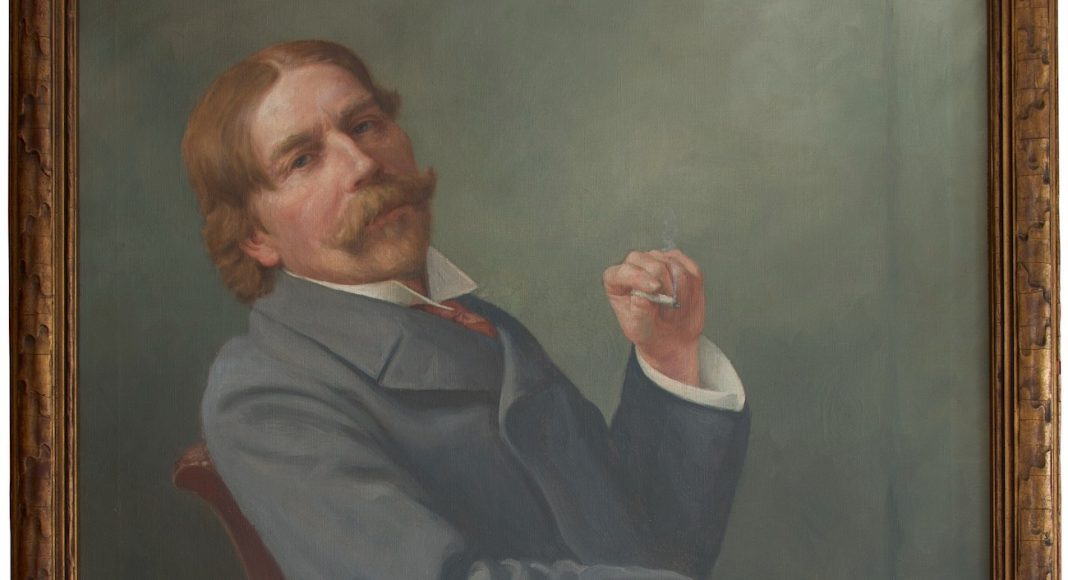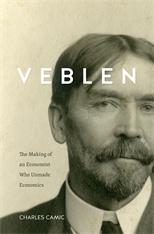In an excerpt from his book Veblen: The Making of an Economist Who Unmade Economics, Charles Camic explores the connection between Thorstein Veblen’s economic ideas and how he was born and bred intellectually.
Editor’s note: The current debate in economics seems to lack a historical perspective. To try to address this deficiency, we decided to launch a Sunday column on ProMarket focusing on the historical dimension of economic ideas. You can read all of the pieces in the series here.
Economic news and information are the stuff of everyday life in the United States and around the world today. Smartphones ping alerts about the latest figures for unemployment and housing starts within seconds of their monthly release by government agencies; news media headline trade accords, executive compensation packages, and the interest rate policies of the Federal Reserve Board; editorial writers describe the data and statistical techniques of economists from Harvard and the Paris School of Economics; and we are all engulfed by the regular outpouring of information on oil prices, averages on the Nasdaq and Nikkei stock indexes, consumer confidence levels, and the price tag of government programs. To imagine our atmosphere purified of these elements is to warp ourselves into another galaxy.
Our forebears, going back a century and a half, would easily recognize our situation, not in fine detail of course, but certainly in its broad outlines. As the United States and the nations of Western Europe industrialized in the second half of the nineteenth century, their elites and citizens were on the watch—though with fewer quantitative tracking measures than we now have—closely attuned to tariff regulations, the currency standard, railway rates and surcharges, court rulings on the structure of corporations, the prices of summer and winter wheat, and the division of shares of the country’s wealth. On these issues—which filled the national newspapers, urban immigrant newspapers, and local town papers—hinged the outcomes of high-stakes electoral contests.
Yet no more than now did “raw” economic data then speak for themselves. Almost without exception, the brute facts arrived before the public prepackaged, accompanied with an intellectual guidebook as to their meaning—with an interpretation that served to convert the voiceless information about the economy into economic knowledge. And, perhaps predictably, these interpretations ranged widely in content, some deeply tinted by the agendas of sharply divided political and social groups, others wanting to maintain more distance from the intergroup conflicts of the age. All the same, whether they preferred a hands-on or arms-length style of intervention into the public arena, most economic writers, including most occupants of the newly established position of the academic economist, had problems closer to home to deal with at the same time. These were their recurring struggles with one another over the proper manner in which to interpret the bare facts of economic life in order to produce the right kind of economic knowledge.
A mild-mannered lion in these struggles over economic knowledge was Thorstein Veblen. Preeminent British economist (and near-miss Nobelist) Joan Robinson once categorized Veblen as “the most original economist born and bred in the USA”; and her encomium—one of scores of similar tributes paid to Veblen over the past 125 years—invites a fundamental question about the relationship between new forms of economic knowledge and the life of the intellectual innovator. My book Veblen: The Making of an Economist Who Unmade Economics pursues that question through a historical study of the connection between Thorstein Veblen’s economic ideas—the distinctive type of economic knowledge he created—and how he was born and bred intellectually.
The process of Veblen’s coming-into-being as an economist was a prolonged one, which lasted from the pre–Civil War period until the final decade of the nineteenth century. Described by present-day historians as the era of the “making of modern America,” these years witnessed massive immigration to the country by northern Europeans, the settlement of the prairies of the Midwest and the mechanization of agriculture, explosive urbanization and industrialization, and the metamorphosis of the country’s institutional infrastructure. Veblen was closely aware of all these changes. Not yet the abstractions of historical monographs, they roiled the places where he lived, as he made his way—by the unbridled invention of the age, the railroad—from a Norwegian immigrant community in rural Minnesota to long-settled areas of the East Coast, and then to Chicago, which (with a population of more than a million and a half) was already the nation’s Second City, as well as the locus of its meatpacking, grain, and lumber industries, its emerging corporate form of capitalist enterprise, and its devices for stimulating mass consumption.
Every one of these great historical developments threaded through Veblen’s life experiences, and all of them feature in his fin de siècle writings. Even so, everyday experiences are multilayered and concatenated, and for much of the time from his boyhood until the end of the nineteenth century Veblen viewed the panorama of his age through the windows of classrooms, at a succession of schools where he was a star student. Initially those schools were local, though with a twist; for, just by luck, Carleton College—newly founded but already academically well-equipped—was only a few miles from his family’s farm, so Carleton was where his parents sent him when he finished common school.
Then, following his college graduation, Veblen entered graduate school, studying at four of the leading American universities of the period, one, Yale University, antique but undergoing major intellectual renovation, the other three—Johns Hopkins University, Cornell University, and the University of Chicago—epicenters of the transformation in higher education that had recently begun in the United States. Not only this, but it was for the explicit purpose of advancing his education that Veblen left the farmstead and moved several times afterward; the forceful pull of the university and the attraction of particular professors occasioned all the major geographical moves he made (except for a timeout back home due to illness). In the course of all these moves, Veblen gradually became an economist, and a highly original one.
“Among the social scientists of Veblen’s generation, no other figure clocked in so many years as a student and apprentice within America’s higher-educational institutions.”
Economics was not his intended destination; at the outset, Veblen aspired to a career as a philosopher, but this plan proved temporary, and soon he was reconsidering his options. One purpose of my book, then, is to follow his intellectual journey step by step, examining Veblen’s pivot into economics and his transformation into an innovative economic thinker as he proceeded—amid the swirling economic and social changes of his age—from the local schoolhouse to Carleton College, Johns Hopkins, Yale, Cornell, and the University of Chicago. Measured in units of time, this trip was a lengthly one. Among the social scientists of Veblen’s generation, no other figure clocked in so many years as a student and apprentice within America’s higher-educational institutions.
In the instance of Veblen, moreover, that long expanse of time was heavily saturated with intellectual repetition—in particular, with the form of repetition I will call “repetition-with-variation” (a notion I borrow from European philosophers and the American sociologist Robert Merton). Viewed solely in terms of formal coursework, the schools Veblen attended varied significantly from one another. At each, he studied different academic subjects with different professors, whose teachings differed in important ways. Despite these variations, however, these institutions all bore a strong family resemblance; at one school after another, Veblen’s teachers, nearly all of them German-educated, did their work by using intellectual practices that were analogous to one another. In this way, they equipped Veblen with equivalent skills, resources, and other intellectual tools—or, in other words, with a similar repertoire of concepts, critical and constructive arguments, and techniques for formulating arguments. This repertoire overlapped, furthermore, with experiences Veblen had beyond the walls of the academy; his formal education and his informal education reinforced each other over the course of many years.
Talented student that he was, Veblen learned the intellectual repertoire he was taught, mastering that repertoire so well that he was able subsequently to expand it and to refine it in order to address issues different from those that concerned his teachers. Sociologists and nonsociological readers alike are likely to find a study of several decades in the life of a nineteenth-century economist an odd project for a sociologist to take on, and perhaps it is. Nonetheless, in the spirit of the African adage that “it takes a village to raise a child,” my aim is to show that this astute sociological principle also applies to knowledge producers, even to a creative knowledge specialist like Thorstein Veblen.
The development of an intellectual innovator, no less than the raising of a child, involves social processes that link the elders of a village to the youth of the next generation. To be sure, this analogy goes only so far, because the “village” inhabited by young intellectuals typically exceeds the physical boundaries of a particular geographical location to encompass multiple locales, just as happened in Veblen’s case. But this widening of intellectual space that has been underway for the last century and a half has not diminished the role of the tribal elders of the academic world. In recent times, the number of those elders has actually grown and, as often as not, their impact on academic newcomers has expanded.
This intergenerational dynamic operates differently in different cases, of course. Repetition-with-variation is only one element in the story of intellectual growth and creativity. As far as I know, however, it is an element that sociologists and other social scientists have all but overlooked. More important, it is an element that we would not expect to play a positive role in the development of thinkers who become innovators. After all, repetition by the village elders of their ideas is the antithesis of new knowledge, is it not? That, at any rate, is what previous writers on Veblen’s work have assumed. But the historical evidence laid out in my book shows that repetition-with-variation may have the opposite effect: the effect of stimulating and facilitating intellectual innovation. And if this statement applies to the extreme case of Thorstein Veblen, it likely holds in other instances too.
Excerpted from Veblen: The Making of an Economist Who Unmade Economics by Charles Camic, published by Harvard University Press. Copyright © 2020 by the President and Fellows of Harvard College. Used by permission. All rights reserved
Learn more about our disclosure policy here.







